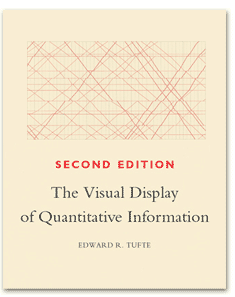定量信息的视觉显示 [书籍]
The Visual Display of Quantitative Information [Book]

Highlights
Introduction
这本书始于1975年,作者给一群记者开的统计学讲座。因为世界上有不计其数的统计图,其中很多有意或无意地歪曲了真实数据的情况,所以教会大家制作好图、辨别烂图,是势在必行的。
为了以大众能接受的价格出版这本书,并且让成书完全按照自己的设计,作者抵押房子搞起了自出版,也算奇葩一朵。
Graphical Excellence
什么是好图?简单说就是要“清晰、精确、明了”。具体说来,视觉显示应该:
- 展示数据 (show the data)
- 引导读者去思考数据本质,而不是方法学、图的设计、制图技术等乱七八糟的其他事情 (induce the viewer to think about the substance rather than about methodology, graphic design, the technology of graphic production, or something else)
- 避免歪曲数据的意思 (avoid distorting what the data have to say)
- 在小空间里呈现许多数据 (present many numbers in a small space)
- 令大数据集有条有理、清晰易懂 (make large data sets coherent)
- 便于读者用肉眼去比较不同部分的数据 (encourage the eye to compare different pieces of data)
- 从概览到细节,分为几个层面来揭示数据 (reveal the data at several levels of detail, from a broad overview to the fine structure)
- 明确展示的目的:描述、探索、列表、装饰 (serve a reasonably clear purpose: description, exploration, tabulation, or decoration)
- 整合了关于数据集的统计和动词描述 (be closely integrated with the statistical and verbal descriptions of a data set)
Graphical Integrity
(未完待续 to be continue)